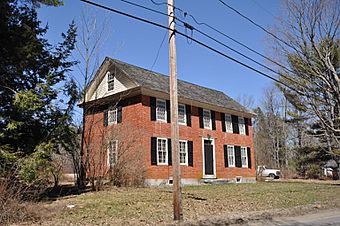Pottersville District facts for kids
Quick facts for kids |
|
|
Pottersville District
|
|
 |
|
| Lua error in Module:Location_map at line 420: attempt to index field 'wikibase' (a nil value). | |
| Location | Roughly intersection of Roxbury and Meadow Rds., and along Brown Rd. NE of Chesham Rd., Harrisville, New Hampshire |
|---|---|
| Area | 93 acres (38 ha) |
| Architectural style | Greek Revival |
| MPS | Harrisville MRA |
| NRHP reference No. | 86003096 |
| Added to NRHP | December 29, 1986 |
The Pottersville District is a special historical area in Harrisville, New Hampshire. It's where the first non-Native settlers built their homes and started businesses. This district also shows us where some of the town's earliest factories and workshops were located. It covers about 93 acres and includes forty old buildings and two places where archaeologists have found ancient items. Because of its important history, the Pottersville District was added to the National Register of Historic Places in 1986.
Contents
Exploring Pottersville's Past
The Pottersville area has a long and interesting history. It was first settled in the 1760s by people who moved here from Massachusetts. Imagine what life was like back then! One house built around 1765 still stands in the district today.
Early Buildings and Community Life
The oldest church in Harrisville is found here. It was built in 1797 by a group of Baptists and is now known as the Chesham Community Church. Right next to the church, you can see the town's oldest schoolhouse, which was built in 1840. These buildings show us how important faith and education were to the early settlers.
The Rise and Fall of Pottery Works
Pottersville was once a busy center for making pottery. By 1795, pottery workshops were already active here. This industry grew a lot in the 1810s. At one point, as many as twelve different pottery businesses were operating! They made dishes and other items that were sold across a wide area in central New England.
However, by about 1860, these pottery businesses faced too much competition and eventually closed down. Today, you can't see the workshops themselves, but archaeologists have found remains of them. They've discovered places where waste materials from the pottery making were dumped, and even sites of old kilns (ovens for firing pottery) and workshops. These findings help us learn about the district's industrial past.
Mills and Other Industries
Besides pottery, the area also had early sawmills and gristmills (mills for grinding grain). These were built in the 1790s near the outlet of Russell Reservoir. You can still find the foundational remains of these old mills, showing where they once stood and helped the community.
Where is the Pottersville District?
The Pottersville District is shaped roughly like a rectangle. It follows Chesham and Brown Roads in the southwestern part of Harrisville.
District Boundaries
- Its western edge is about 100 feet west of where Chesham Road and Old Marlboro Road meet.
- The eastern edge is on Brown Road, roughly across from the eastern end of Russell Reservoir.
- The northern and southern boundaries extend about 350 feet north and south from the line of Chesham and Brown Roads.
This makes it easy to imagine the area that holds so much history!

